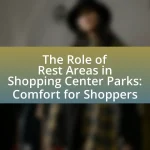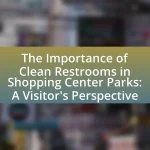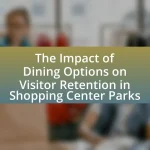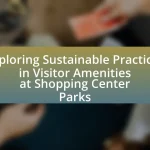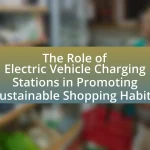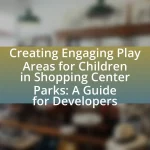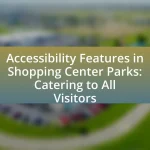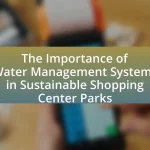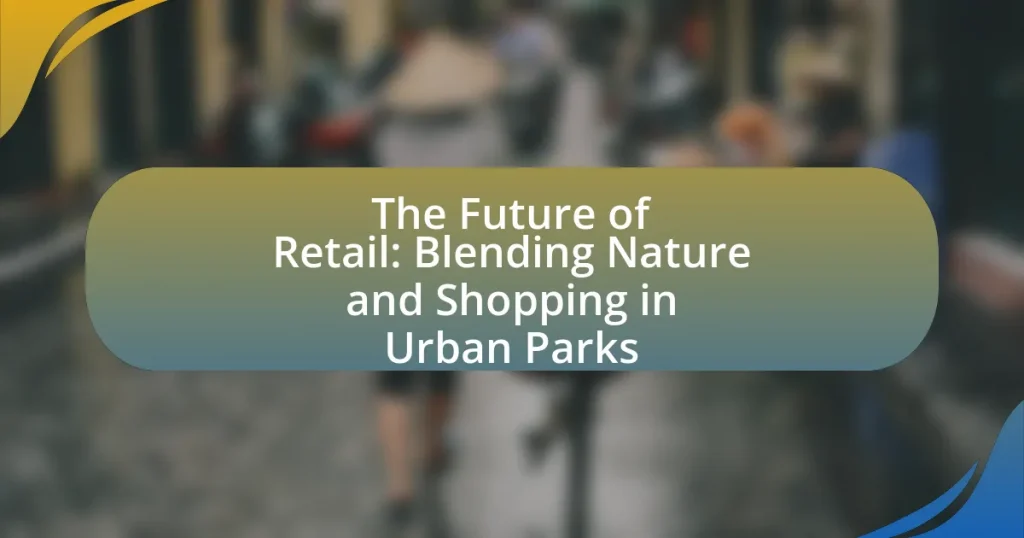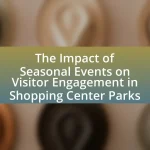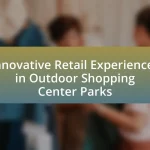The article explores the concept of blending nature and shopping in urban parks, highlighting how integrating retail spaces within natural environments enhances the shopping experience while promoting sustainability. It discusses the redefinition of traditional retail through biophilic design and the positive influence of nature on consumer behavior, leading to increased customer satisfaction and sales. Key elements of this integration include the use of natural materials, greenery, and sustainable practices, which contribute to environmental benefits and community well-being. The article also examines current trends in urban park retail, the role of technology, and the challenges retailers face in this evolving landscape.

What is the concept of blending nature and shopping in urban parks?
The concept of blending nature and shopping in urban parks involves integrating retail spaces within natural environments to enhance the shopping experience while promoting sustainability. This approach aims to create a harmonious balance between commercial activities and green spaces, allowing consumers to enjoy shopping amidst nature. Research indicates that such integration can improve customer satisfaction and increase foot traffic, as seen in projects like the High Line in New York City, where retail elements coexist with landscaped areas, attracting millions of visitors annually. This model not only supports local businesses but also encourages environmental stewardship by utilizing green design principles.
How does this concept redefine the traditional retail experience?
This concept redefines the traditional retail experience by integrating shopping with natural environments, creating a more immersive and engaging atmosphere for consumers. By situating retail spaces within urban parks, businesses can enhance customer experiences through the benefits of nature, such as improved mental well-being and increased foot traffic. Research indicates that environments incorporating greenery can lead to a 20% increase in customer dwell time and a 15% boost in sales, demonstrating the effectiveness of this approach in attracting and retaining shoppers.
What are the key elements of integrating nature into retail spaces?
The key elements of integrating nature into retail spaces include biophilic design, natural materials, greenery, and sustainable practices. Biophilic design emphasizes the connection between people and nature, enhancing customer experience and well-being. Natural materials, such as wood and stone, create a warm and inviting atmosphere, while incorporating greenery, like plants and living walls, improves air quality and aesthetic appeal. Sustainable practices, including energy-efficient systems and water conservation, further align retail spaces with environmental stewardship, as evidenced by studies showing that such integrations can increase customer satisfaction and sales by up to 15%.
How does the presence of nature influence consumer behavior?
The presence of nature positively influences consumer behavior by enhancing mood and increasing the likelihood of spending. Research indicates that environments enriched with natural elements, such as plants and green spaces, lead to reduced stress and improved emotional well-being, which in turn encourages consumers to engage more with retail spaces. A study published in the Journal of Environmental Psychology found that shoppers in natural settings reported higher levels of satisfaction and were willing to spend more time and money compared to those in urban, non-green environments. This correlation suggests that integrating nature into retail spaces can significantly boost consumer engagement and sales.
Why is the integration of retail and nature becoming important in urban planning?
The integration of retail and nature is becoming important in urban planning because it enhances the quality of life for residents and promotes sustainable economic growth. Urban areas increasingly face challenges such as pollution, heat islands, and limited green spaces, which negatively impact community well-being. Research indicates that incorporating natural elements into retail environments can improve mental health, increase foot traffic, and boost sales by creating inviting spaces. For example, a study by the University of Queensland found that green spaces in urban settings can lead to a 20% increase in retail sales, demonstrating the economic benefits of this integration.
What are the environmental benefits of urban parks with retail spaces?
Urban parks with retail spaces provide significant environmental benefits, including improved air quality, enhanced biodiversity, and effective stormwater management. These parks contribute to air purification by absorbing pollutants and carbon dioxide, which is supported by studies indicating that urban greenery can reduce particulate matter by up to 30%. Additionally, the integration of retail spaces within parks encourages sustainable practices, such as the use of green roofs and permeable surfaces, which help manage rainwater runoff and reduce urban heat islands. Furthermore, these parks serve as habitats for various species, promoting biodiversity in urban settings, with research showing that urban green spaces can support up to 50% more wildlife compared to non-green areas.
How do urban parks contribute to community well-being and social interaction?
Urban parks significantly enhance community well-being and foster social interaction by providing accessible green spaces for recreation, relaxation, and community gatherings. These parks serve as vital social hubs where individuals can engage in physical activities, such as walking, jogging, and playing sports, which contribute to improved physical health and mental well-being. Research indicates that access to green spaces is linked to reduced stress levels and increased happiness among residents. For instance, a study published in the journal “Environmental Science & Technology” found that individuals living near parks reported higher levels of physical activity and lower levels of depression. Additionally, urban parks facilitate social connections by hosting community events, markets, and festivals, which encourage interaction among diverse groups, thereby strengthening community ties and promoting inclusivity.
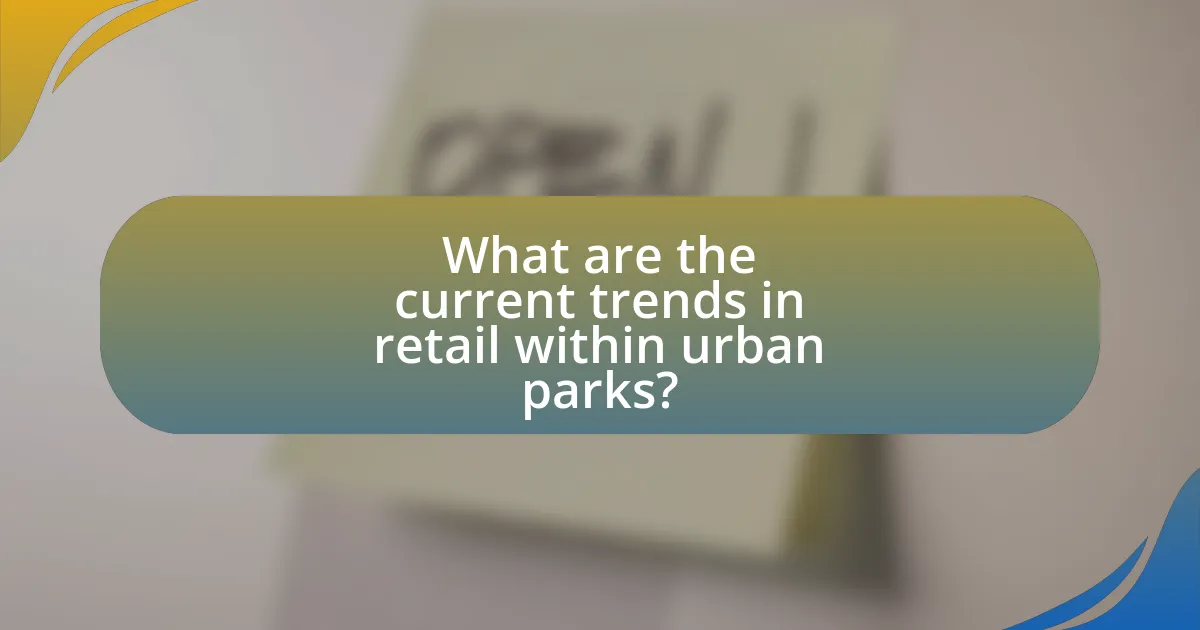
What are the current trends in retail within urban parks?
Current trends in retail within urban parks include the rise of pop-up shops, food trucks, and experiential retail spaces that enhance visitor engagement. These trends reflect a shift towards creating immersive shopping experiences that integrate nature and community interaction. For instance, cities like New York and San Francisco have seen an increase in temporary retail installations that offer unique products and services while promoting local businesses. Additionally, research indicates that urban parks with retail elements can increase foot traffic and enhance the overall visitor experience, making them attractive locations for retailers looking to connect with consumers in a relaxed environment.
How are retailers adapting to the demands of eco-conscious consumers?
Retailers are adapting to the demands of eco-conscious consumers by implementing sustainable practices and offering eco-friendly products. Many retailers are now prioritizing the use of renewable materials, reducing plastic packaging, and increasing transparency in their supply chains. For instance, a report from Nielsen indicates that 66% of global consumers are willing to pay more for sustainable brands, prompting retailers to align their offerings with these preferences. Additionally, retailers are enhancing their recycling programs and promoting circular economy initiatives, which resonate with the values of eco-conscious shoppers.
What types of retail formats are emerging in urban park settings?
Emerging retail formats in urban park settings include pop-up shops, food trucks, and experiential retail spaces. These formats cater to the outdoor environment and enhance visitor engagement by providing unique shopping experiences that integrate with nature. For instance, pop-up shops allow brands to create temporary retail experiences that attract park visitors, while food trucks offer convenient dining options that complement recreational activities. Additionally, experiential retail spaces focus on interactive experiences, such as workshops or events, that draw people into the park and encourage longer stays. This trend reflects a growing demand for retail that harmonizes with outdoor spaces, promoting both commerce and community interaction.
How do pop-up shops and local markets fit into this trend?
Pop-up shops and local markets align with the trend of blending nature and shopping in urban parks by creating immersive, community-focused retail experiences that enhance the natural environment. These temporary retail spaces often utilize outdoor settings, allowing consumers to engage with products in a relaxed, scenic atmosphere, which fosters a connection to nature. For instance, a study by the Urban Land Institute highlights that integrating retail with green spaces can increase foot traffic and community engagement, demonstrating that shoppers are drawn to environments that combine commerce with natural elements. This trend not only supports local businesses but also promotes sustainability by encouraging outdoor shopping experiences that reduce reliance on traditional retail spaces.
What role does technology play in enhancing the shopping experience in urban parks?
Technology significantly enhances the shopping experience in urban parks by providing interactive and convenient solutions for consumers. For instance, mobile applications enable visitors to locate shops, access digital maps, and receive real-time updates on promotions and events. Additionally, augmented reality (AR) can create immersive experiences, allowing shoppers to visualize products in a natural setting before making a purchase. According to a study by the National Retail Federation, 70% of consumers prefer retailers that offer mobile-friendly services, indicating that technology-driven enhancements can lead to increased customer satisfaction and engagement in urban park shopping environments.
How can augmented reality be used to blend nature and shopping?
Augmented reality can be used to blend nature and shopping by creating immersive experiences that allow consumers to interact with products in natural settings. For instance, retailers can develop AR applications that overlay digital information about products onto real-world environments, enabling shoppers to visualize how items, such as outdoor gear or plants, would look in their own gardens or parks. Research indicates that 61% of consumers prefer shopping experiences that incorporate AR, as it enhances engagement and decision-making. By integrating AR technology in urban parks, retailers can attract customers by providing interactive trails or displays that showcase products in a natural context, thereby fostering a connection between nature and retail.
What are the benefits of mobile apps for consumers in urban park retail environments?
Mobile apps provide consumers in urban park retail environments with enhanced convenience, personalized experiences, and improved access to information. These applications allow users to easily locate stores, view product offerings, and receive real-time updates on promotions or events happening in the park. For instance, a study by the National Retail Federation indicates that 79% of consumers prefer using mobile apps for shopping due to their ability to streamline the purchasing process and enhance engagement with brands. Additionally, mobile apps can facilitate contactless payments and loyalty programs, further enriching the shopping experience while promoting safety and efficiency in urban park settings.
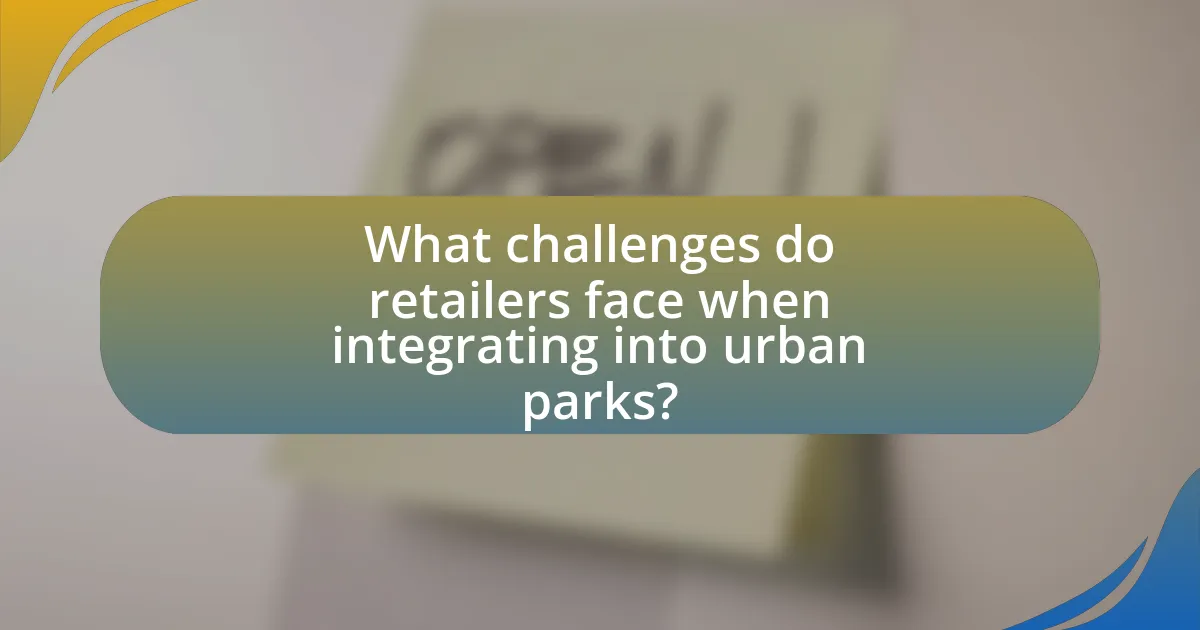
What challenges do retailers face when integrating into urban parks?
Retailers face several challenges when integrating into urban parks, primarily including regulatory hurdles, logistical issues, and consumer behavior adaptation. Regulatory hurdles often involve navigating complex zoning laws and obtaining necessary permits, which can delay or complicate the integration process. Logistical issues arise from the need to establish supply chains and infrastructure that accommodate outdoor settings, such as utilities and waste management. Additionally, retailers must adapt to consumer behavior, as shoppers may have different expectations and experiences in a park environment compared to traditional retail spaces. These challenges are supported by studies indicating that successful integration requires careful planning and collaboration with local authorities and community stakeholders.
How do zoning laws and regulations impact retail development in parks?
Zoning laws and regulations significantly influence retail development in parks by dictating land use, building specifications, and operational guidelines. These laws determine what types of retail activities can occur within park boundaries, often prioritizing recreational and environmental preservation over commercial interests. For instance, many parks are zoned for public use, which can limit the extent and nature of retail establishments, such as prohibiting large-scale commercial developments to maintain the park’s natural character. Additionally, regulations may impose restrictions on signage, hours of operation, and the types of products sold, ensuring that retail activities align with the park’s purpose and community standards. This regulatory framework aims to balance economic development with environmental stewardship, ultimately shaping the retail landscape within urban parks.
What are the common obstacles in maintaining the balance between nature and commerce?
Common obstacles in maintaining the balance between nature and commerce include environmental degradation, regulatory challenges, and conflicting stakeholder interests. Environmental degradation occurs when commercial activities, such as retail development, lead to habitat destruction and pollution, negatively impacting local ecosystems. Regulatory challenges arise from the need to comply with environmental laws and zoning regulations, which can hinder commercial expansion. Conflicting stakeholder interests, such as those between businesses seeking profit and communities advocating for green spaces, complicate decision-making processes. These factors collectively create significant barriers to achieving a harmonious integration of nature and commerce in urban settings.
How can retailers address sustainability concerns in urban park settings?
Retailers can address sustainability concerns in urban park settings by implementing eco-friendly practices such as using sustainable materials, reducing waste, and promoting local sourcing. For instance, retailers can utilize biodegradable packaging and energy-efficient technologies to minimize their environmental footprint. According to a report by the World Economic Forum, sustainable retail practices can lead to a 30% reduction in carbon emissions. Additionally, engaging in community initiatives, such as tree planting or park clean-up events, can enhance their commitment to sustainability while fostering a positive relationship with the local community.
What strategies can retailers employ to succeed in urban park environments?
Retailers can succeed in urban park environments by creating experiential shopping opportunities that integrate nature and community engagement. This strategy involves designing retail spaces that enhance the natural surroundings, such as using sustainable materials and incorporating greenery, which can attract customers seeking a unique shopping experience. For instance, retailers can host outdoor events, workshops, or pop-up markets that encourage social interaction and draw foot traffic from park visitors. Research indicates that retail spaces that prioritize customer experience and environmental aesthetics can increase dwell time and sales, as seen in successful urban park retail initiatives like the High Line in New York City, where businesses thrive due to their connection to the park’s vibrant atmosphere.
How can collaboration with local communities enhance retail success?
Collaboration with local communities enhances retail success by fostering trust and loyalty among consumers. When retailers engage with community members, they can tailor their offerings to meet local preferences, resulting in increased customer satisfaction and repeat business. For instance, a study by the National Retail Federation found that businesses that actively participate in community events see a 20% increase in customer retention rates. Additionally, local partnerships can lead to co-marketing opportunities, expanding reach and visibility. By aligning with community values and needs, retailers can create a more personalized shopping experience, ultimately driving sales and enhancing brand reputation.
What marketing approaches are effective for attracting consumers to urban park retail?
Effective marketing approaches for attracting consumers to urban park retail include experiential marketing, community engagement, and digital promotions. Experiential marketing creates immersive experiences that connect consumers with the natural environment, enhancing their shopping experience. Community engagement fosters local partnerships and events that draw foot traffic, such as farmers’ markets or outdoor concerts, which have been shown to increase visitor numbers by up to 30%. Digital promotions, including targeted social media advertising and location-based offers, leverage technology to reach potential customers in real-time, driving awareness and footfall. These strategies collectively enhance visibility and appeal, making urban park retail more attractive to consumers.
What are best practices for creating a successful retail experience in urban parks?
To create a successful retail experience in urban parks, it is essential to integrate nature with shopping by offering unique, locally-sourced products that resonate with the park’s environment. This approach attracts visitors who seek both leisure and shopping, enhancing their overall experience. Research indicates that retail spaces in natural settings can increase customer dwell time by up to 30%, as people are more likely to linger in pleasant environments. Additionally, incorporating pop-up shops and food vendors that reflect the local culture can create a vibrant atmosphere, encouraging repeat visits. Engaging community events, such as markets or workshops, further enhance the retail experience by fostering a sense of community and connection to the park.
